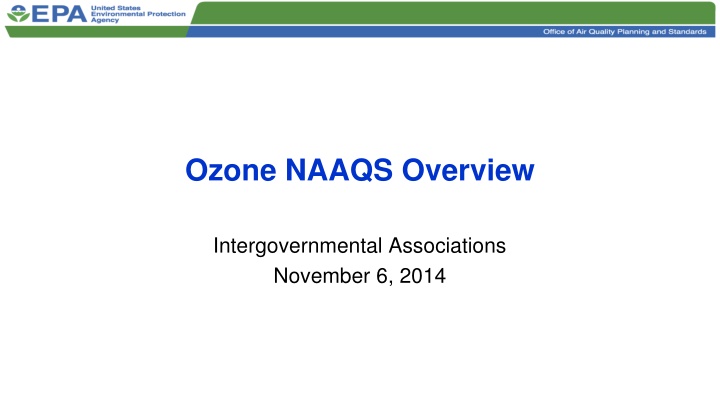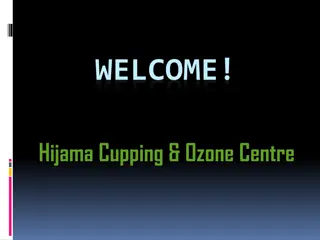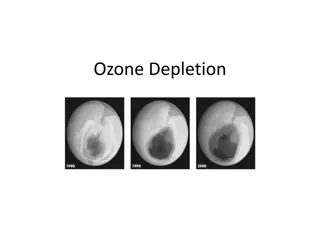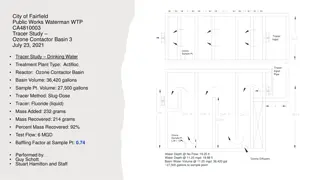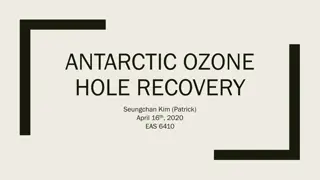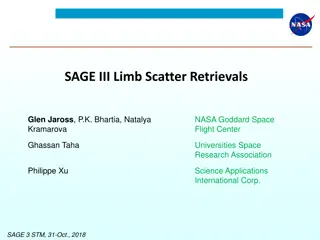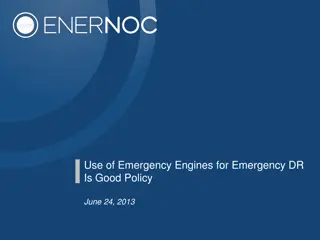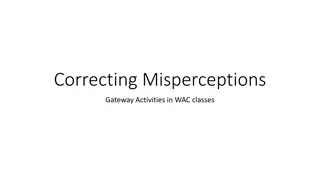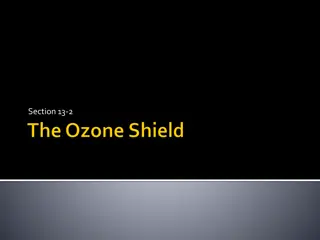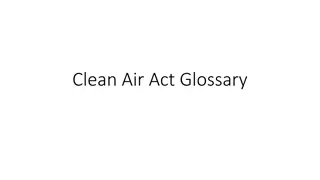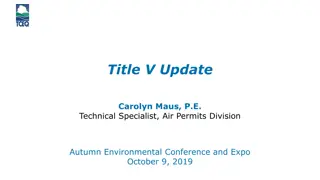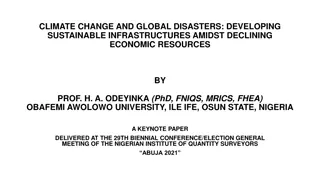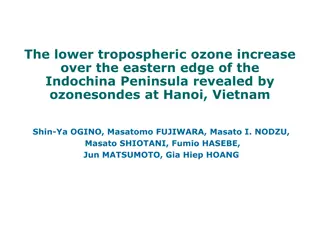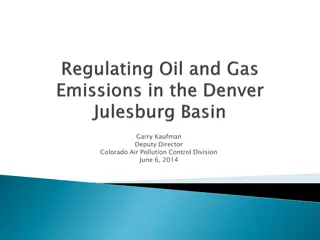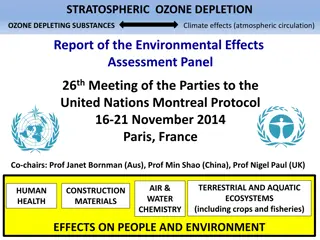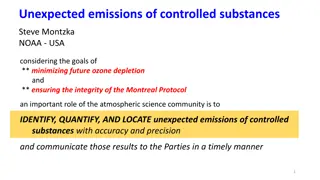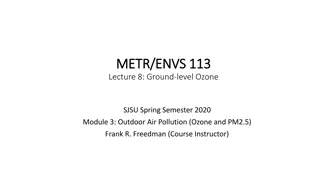Ozone NAAQS Overview
In the realm of software development, tools like Clang-tidy play a crucial role in detecting and addressing coding and design problems early in the development process. This reduces the overall cost of fixing bugs that escalate after release. Through examples and references, explore the significance of syntax and static analyzers, and understand how these tools seamlessly integrate into the software development workflow to enhance code quality and efficiency.
Download Presentation

Please find below an Image/Link to download the presentation.
The content on the website is provided AS IS for your information and personal use only. It may not be sold, licensed, or shared on other websites without obtaining consent from the author.If you encounter any issues during the download, it is possible that the publisher has removed the file from their server.
You are allowed to download the files provided on this website for personal or commercial use, subject to the condition that they are used lawfully. All files are the property of their respective owners.
The content on the website is provided AS IS for your information and personal use only. It may not be sold, licensed, or shared on other websites without obtaining consent from the author.
E N D
Presentation Transcript
Ozone NAAQS Overview Intergovernmental Associations November 6, 2014
Overview Provide a general overview of the National Ambient Air Quality Standard (NAAQS) review process; Describe the review of the current standard and where we are in the process; Update you on the status of the proposed implementation rule for the current (2008) ozone standards; and Discuss current air quality and monitoring information. 2
Overview of NAAQS Development Tom Powers Senior Policy Advisor Office of Air and Radiation
Overarching Questions for NAAQS Reviews Does the currently available scientific evidence and exposure/risk information support or call into question the adequacy of the protection afforded by the current primary and/or secondary standard(s)? Primary NAAQS protect public health, including the health of at-risk populations and lifestages, with an adequate margin of safety Secondary NAAQS protect public welfare from any known or anticipated adverse effects What alternative standards, if any, are supported by the currently available scientific evidence and exposure/risk- based information, and are appropriate for consideration? 4
NAAQS Review Process Workshop on science-policy issues Integrated Review Plan (IRP): timeline and key policy-relevant issues and scientific questions Integrated Science Assessment (ISA): evaluation and synthesis of most policy-relevant studies Peer-reviewed scientific studies Clean Air Scientific Advisory Committee (CASAC) review Risk/Exposure Assessment (REA): quantitative assessment, as warranted, focused on key results, observations, and uncertainties Public comment Policy Assessment (PA): staff analysis of policy options based on integration and interpretation of information in the ISA and REA EPA Agency decision making and draft proposal notice proposed decisions on standards Interagency review Public hearings and comments on proposal Agency decision making and draft final notice EPA final decisions on standards Interagency review 5
Rulemaking Notice of Proposed Rulemaking Propose decisions based on consideration of staff conclusions in Policy Assessment and CASAC advice/recommendations. Solicit public comment on proposed elements of NAAQS and alternatives, as appropriate. Public review process: Public comment period, including public hearing(s), follows publication of proposed rule. Final Rulemaking Notice Final decisions take into account public comments on proposed rule. Response-to-Comments document prepared/finalized in parallel with final rule. NAAQS rulemaking may be accompanied by or combined with rulemaking changes to monitoring, Air Quality Index (AQI), and/or implementation regulations. 6
NAAQS Reviews: Status Update (as of November 2014) Secondary NO2 and SO2 Primary NO2 Primary SO2 Ozone Lead PM CO Last Review Completed (final rule signed) Mar 2008 Oct 2008 Jan 2010 Jun 2010 Mar 2012 Dec 2012 Aug 2011 August 2014 Final REAs Final PA Kickoff workshop for next review targeted for early 2015 June 2014 Final IRP May 2014 Final PA Recent or Upcoming Major Milestone(s)1 October 2014 Final IRP Fall 2014 Draft IRP Dec 1, 2014 2 Proposed rule TBD3 Fall 2014 2nd Draft ISA 2014 Proposed rule Oct 1, 2015 2 Final rule Additional information regarding current and previous NAAQS reviews is available at: http://www.epa.gov/ttn/naaqs/ 1 IRP Integrated Review Plan; ISA Integrated Science Assessment; REA Risk and Exposure Assessment; PA Policy Assessment 2 Bold and underlined dates indicate court-ordered or settlement agreement deadlines 3 TBD = to be determined
Ozone NAAQS Update Erika Sasser Director, Health and Environmental Impacts Division OAQPS
Ozone NAAQS History March 27, 2008: EPA revises primary and secondary ozone standards from 84 ppb to 75 ppb (8-hour average). In 2013, the D.C. Circuit remanded the secondary standard to the Agency for reconsideration because the Agency did not determine what level of protection was requisite to protect the public welfare. EPA proposes to reconsider the 2008 ozone standard. Change primary standard to within range of 60 to 70 ppb. Change secondary standard to cumulative seasonal standard within range of 7 to 15 ppm-hours. President asks EPA to withdraw its January 2010 proposal and focus on upcoming 5 year review. Coalition of public health and environmental groups, including Sierra Club and ALA, file lawsuit in federal court asking court to set deadline for action on overdue ozone standards. U.S. District Court in San Francisco orders EPA to issue new ozone standards (proposal by Dec.1, 2014, final by Oct.1, 2015). January 19, 2010: September 2, 2011: June 19, 2013: April 29, 2014: 9
NAAQS Statutory Requirements (CAA 109) Primary (health-based) standards shall be ambient air quality standards . . .which in the judgment of the Administrator are requisite to protect public health, including at-risk groups, with an adequate margin of safety Secondary (welfare-based) standards: specify a level of air quality the attainment and maintenance of which in the judgment of the Administrator is requisite to protect the public welfare from any known or anticipated adverse effects An independent scientific review committee, the Clean Air Scientific Advisory Committee (CASAC), shall review the science and standards and shall recommend to the Administrator any new . . . standards and revisions of existing . . . standards as may be appropriate In setting standards: EPA is required to engage in reasoned decision making to translate scientific uncertainty into standards. EPA may not consider cost. Rather, cost is considered in developing control strategies to meet the standards. 10
NAAQS Review Process Workshop on science-policy issues Integrated Review Plan (IRP): timeline and key policy-relevant issues and scientific questions Integrated Science Assessment (ISA): evaluation and synthesis of most policy-relevant studies Peer-reviewed scientific studies Clean Air Scientific Advisory Committee (CASAC) review Risk/Exposure Assessment (REA): quantitative assessment, as warranted, focused on key results, observations, and uncertainties Public comment Policy Assessment (PA): staff analysis of policy options based on integration and interpretation of information in the ISA and REA EPA Agency decision making and draft proposal notice proposed decisions on standards Interagency review Public hearings and comments on proposal Agency decision making and draft final notice EPA final decisions on standards Interagency review 11
Science-Based Conclusions on Primary Standard CASAC concluded and EPA staff assessment agrees that: Current evidence and exposure/risk information call into question the adequacy of public health protection provided by current standard (75 ppb). It is appropriate to consider revising the standard to provide greater public health protection, with range of levels from 60-70 ppb, in conjunction with the current indicator (O3), averaging time (8-hour), and form (3-year average of 4th highest daily maximum). There is no bright line between 60-70 ppb. Lower levels provide incrementally greater health protection and reductions in risk, but there is more uncertainty. A level set at the higher end of range provides additional protection beyond 75 ppb and reduces the number of days ozone levels will exceed the lower end of the range. CASAC advice: A level of 70 ppb provides little margin of safety for the protection of public health, particularly for sensitive subpopulations and there is substantial scientific evidence that adverse effects occur at 70 ppb. Set the level of the standard lower than 70 ppb within a range down to 60 ppb, taking into account your judgement regarding margin of safety. 12
Science-Based Conclusions on Secondary Standard Ozone has detrimental effects on vegetation, including both crops and trees. Plant response to ozone depends on both the level and cumulative nature of exposures over the growing season. Specialized metrics (such as W126 cumulative weighted index) are used to measure potential impacts on vegetation. There is little research available to inform judgments on the degree to which an impact should be considered adverse to public welfare. CASAC concluded and EPA staff assessment agrees that current welfare effects evidence and exposure/risk information call into question the adequacy of public welfare protection by current 75 ppb standard. It is appropriate to consider revision of form, level and averaging time to increase public welfare protection. CASAC advised that the secondary standard should be in terms of a cumulative, seasonal form (i.e., W126) set at a level within the range of an annual average of 7 to 15 ppm-hrs. EPA staff concluded it is appropriate to consider a cumulative W126 standard from 7 to 17 ppm-hrs, averaged over 3 years. 13
NAAQS Review Process Workshop on science-policy issues Integrated Review Plan (IRP): timeline and key policy-relevant issues and scientific questions Integrated Science Assessment (ISA): evaluation and synthesis of most policy-relevant studies Peer-reviewed scientific studies Clean Air Scientific Advisory Committee (CASAC) review Risk/Exposure Assessment (REA): quantitative assessment, as warranted, focused on key results, observations, and uncertainties Public comment Policy Assessment (PA): staff analysis of policy options based on integration and interpretation of information in the ISA and REA EPA Agency decision making and draft proposal notice proposed decisions on standards Interagency review Public hearings and comments on proposal Agency decision making and draft final notice EPA final decisions on standards Interagency review 14
Ozone Proposal Coming Up The Administrator s task is to decide whether the current ozone standards are adequate to protect public health and public welfare. We have developed our proposal after a robust review of the science (1000+ new studies) and after considering CASAC s recommendations and those of our staff scientists, bearing in mind the need to translate scientific uncertainty into regulatory standards. We are on track to meet a court-ordered deadline for Notice of Proposed Rulemaking of December 1, 2014. Interagency review is underway. A public comment period and public hearings will follow the proposal. Court-ordered deadline for final rule is October 1, 2015.
If NAAQS is Revised: Implementation Key implementation milestones if NAAQS is revised Area designations promulgated by October 2017 State infrastructure plans (i-SIPs) due October 2018 Attainment plans and demonstrations due 2020/2021 (only Moderate and above areas) Attainment dates 2020-2037 (primary standard only) Implementation-related proposals for next ozone NAAQS Intend to include proposals on limited grandfathering of PSD permit applications and process deadlines for ozone-related exceptional events demonstrations with NAAQS review proposal. Also, intend to seek early input on implementation-related issues and challenges.
Proposed SIP Requirements Rule for the 2008 Ozone NAAQS Scott Mathias Associate Division Director Air Quality Policy Division
Timeline Proposal signed by Administrator May 29, 2013 Published in the Federal Register June 6, 2013 (78 FR 34178) Official title: Implementation of the 2008 National Ambient Air Quality Standards for Ozone: State Implementation Plan Requirements Public comment period began June 6, 2013 Comment period ended September 4, 2013 54 comment letters received Docket number: EPA HQ OAR 2010 0885 Final rule package was entered into regulatory review at OMB on October 11, 2014. 18
Purposes of the Rulemaking Provide states with clear rules and guidance for planning to meet the 2008 ozone NAAQS in designated nonattainment areas. Translate ozone implementation requirements contained in the 1990 Clean Air Act Amendments (written specific for the 1-hour standard) into meaningful requirements for the 2008 8-hour ozone NAAQS. Revoke the 1997 8-hour ozone NAAQS in order to provide additional flexibility to areas still working to complete the control requirements of that NAAQS. 19
Related Rulemakings Nonattainment area classification scheme and initial area designations were completed in separate rulemakings. Classifications and Attainment Deadlines Signed by Administrator April 30, 2012. Published in Federal Register May 21, 2012 (77 FR 30160). Established end-of-calendar-year attainment dates. Rulemaking also revoked the 1997 NAAQS for purposes of transportation conformity to alleviate dual planning requirements. Initial Area Designations 46 initial nonattainment areas. Signed by Administrator April 30, 2012 (May 31, 2012 for Chicago). Published in Federal Register May 21, 2012 (77 FR 30088) Effective date July 20, 2012. 20
Area Designations for 2008 Ozone NAAQS (Effective July 20, 2012) Greater Connecticut Sheboygan Upper Green River Basin Jamestown Dukes MA Allentown Reading Tuscan Buttes Sacramento Cleveland Chico New York Chicago Nevada Co Lancaster Philadelphia Columbus San Francisco Pittsburgh Calaveras Co Mariposa Co Uintah Basin Seaford DE Denver Baltimore Washington DC/VA St. Louis San Joaquin Valley Cincinnati San Luis Obispo E. Kern Co Ventura Co West Mojave Knoxville Charlotte Morongo Tribe Riverside Co LA-South Coast Memphis Pechanga Tribe San Diego Imperial Co Phoenix Atlanta Dallas Baton Rouge Houston 21
NONATTAINMENT AREASFOR 2008 OZONE NAAQS BY CLASSIFICATION (EFFECTIVE JULY 20, 2012) X Morongo Tribe Pechanga Tribe EPA Final Classifications and Area Counts EPA did not designate as nonattainment any areas outside the Continental U.S. Map reflects classifications following requests for voluntary bump-ups 22
Preamble Outline of Ozone SIP Requirements Rule A. Nonattainment area SIP deadlines B. Modeling and attainment demonstration requirements C. RFP requirements D. RACM and RACT requirements E. Vehicle I/M F. Transportation conformity G. General conformity H. Contingency measures I. NSR J. Emission inventory and emission statement requirements K. Ambient monitoring requirements L. 1-year attainment deadline extensions M. Transport of ground-level ozone for rural nonattainment areas, multi-state nonattainment areas, and international transport N. Section 182(f) NOx provisions O. Emissions benefits of energy efficiency/renewable energy programs, land use planning, and travel efficiency P. Multi-pollutant approach to developing SIPs Q. Tribes R. Ozone Transport Regions (OTRs) S. Additional requirements related to enforcement and compliance T. Emergency episodes U. Clean Data Policy V. Assistance W. Section 185 penalty fee provision for Severe and Extreme areas 23
CAA Nonattainment Area SIP Submittal Deadlines The CAA establishes maximum statutory deadlines for submitting various SIP elements (from effective date of designation). Emission inventories and emission statement SIPs are due from states with Marginal and higher areas no later than 2 years (July 20, 2014). Reasonably Available Control Technology (RACT) SIPs are due from Moderate and higher areas, and all states no later than the Ozone Transport Region (OTR), within 2 years (July 20, 2014). 15% Reasonable Further Progress (6-year RFP) SIPs are due no later than 3 years (July 20, 2015). Attainment plan with Reasonably Available Control Measures (RACM) and attainment demonstration SIPs due no later than 3 years (Moderate) or 4 years (Serious and higher) (July 20, 2015 or July 20, 2016) RFP SIPs showing an average of 3% reductions in emissions per year after the initial 6-year period are due no later than 4 years for Serious and higher areas (July 20, 2016). 185 penalty fee program SIPs are due for Severe and Extreme areas no later than 10 years (July 20, 2022). If EPA determines that an area attains before SIPs are due, the planning SIP submittal requirements can be suspended for as long as the area attains (Clean Data Policy). 24
Proposed SIP Due Dates For Moderate and higher areas, EPA proposed two options for deadlines for certain nonattainment area SIPs (RACT SIPs, attainment demonstration SIPs, and RFP SIPs): Option 1: staggered timeframes provided by statute. Option 2: states may choose to submit SIPs by the staggered deadlines provided by statute, or they may submit a combined submittal of emissions inventory, emission statement, RACT, RFP, attainment plan (RACM), and attainment demonstration SIPs within 30 months (November 20, 2014). Serious and above areas would have the CAA maximum of 4 years to develop attainment demonstration (RACM) and RFP SIPs. This proposal, while consistent with the CAA, differs from the 3-year deadline provided for the 1997 ozone NAAQS. 25
Modeling Attainment Demonstrations Serious and above areas (and multi-state Moderate areas) are required to use photochemical grid modeling to demonstrate attainment. Moderate areas are required to use photochemical modeling as well. However, an alternative approach can be used for Moderate areas if the Administrator determines that it is at least as effective. Model results are used to determine the amount of VOC and/or NOx emission reductions that are needed for the area to attain the NAAQS. EPA has specified approved models and has issued guidance. http://www.epa.gov/scram001/guidance/guide/final-03-pm-rh-guidance.pdf. The preamble directs the reader to the current modeling guidance. The guidance addresses how high electricity demand days (HEDDs) can be characterized. EPA is in the process of updating the guidance for the 2008 ozone NAAQS. 26
Reasonable Further Progress (RFP) Proposals Proposed to specify 2011 as the base year for RFP. Corresponds to periodic emissions inventory submission year closest to the 2012 designation year. Proposed to allow areas to also choose 2012 (the designation year), or another year prior to 2011. Allows areas that began early reductions in 2008 when standard was set to take credit for those reductions in RFP plans. In exchange for flexibility, areas need to provide additional 3% per year RFP for each year that is prior to 2011 (e.g., a 2008 baseline year would require 15% + 3x3% = 24% reduction for years 2009 through 2017). Consistent with approach taken for the 1997 ozone NAAQS. Proposed to allow credit for reductions from sources within the same nonattainment area. We requested specific comment on a legal basis for crediting reductions from outside the nonattainment area toward RFP under CAA subpart 2. Eliminate pre-1990 adjustments calculation for RFP. Proposed that states no longer need to calculate and deduct emissions related to pre-1990 motor vehicle, RVP, and vehicle I/M program corrections (per CAA section 182(b)(1)(D)). The calculations are tedious and the emissions are de minimis. 27
Options for 15% VOC Reduction for First 6 Years (RFP) 15% reduction plan is required for Moderate and above areas and all areas of the OTR. CAA requires these reductions to be VOC-only, even though NOx reductions are now known in some cases to be more effective at reducing ozone. Additional VOC reductions could be difficult to achieve for some long-standing nonattainment areas. Serious and higher are also required to achieve an average of 3%/year reduction in emissions (can be VOC, NOx or a combination) starting 6 years after designation until the attainment date. Proposed flexibility would allow states to substitute NOx for VOC in an area s 15% SIP 1997 ozone rules allowed this approach for areas that previously had an approved 15% RFP plan for the 1-hour NAAQS. 28
Vehicle Requirements Vehicle inspection and maintenance programs are required in all Moderate and above ozone nonattainment areas with a population over 200,000 (or over 100,000 for OTR). There are currently no new I/M areas for the 2008 ozone NAAQS. In this proposal, EPA solicited comment on aligning the I/M SIP deadline with the attainment SIP deadline. EPA also notes ability to approve alternative mobile source controls getting equivalent reductions in place of I/M. Lastly, EPA identifies implementation flexibilities for I/M programs made possible by predominance of onboard diagnostics (OBD) in current fleet. 29
Revoking 1997 NAAQS and Anti-backsliding Requirements Proposed revocation of the 1997 ozone NAAQS effective on the date the final SIP Requirements Rule is published in the Federal Register. Areas still designated nonattainment for the 1997 NAAQS on that date will be subject to anti-backsliding requirements. Will also apply to areas that were nonattainment for the 1-hour NAAQS when it was revoked on June 15, 2005. Proposed that any interstate transport control requirements associated with a prior NAAQS would continue to apply. 30
Anti-backsliding Summary Proposed requirements reflect D.C. Circuit decisions on anti-backsliding and would codify approaches we use now in implementing 1-hour NAAQS anti-backsliding. All prior control requirements and associated triggering mechanisms would be retained. Would include section 185 fee programs, contingency measures for failure to make RFP or attain, and nonattainment NSR provisions associated with the prior classification. Proposed two valid paths for completing fulfillment of anti-backsliding requirements: Redesignation to attainment for the 2008 ozone NAAQS, or EPA approval of a redesignation substitute for the revoked NAAQS. 31
When/How Anti-backsliding Applies Designation for 2008 NAAQS Designation for previous NAAQS (at time of revocation) Attainment/ Maintenance Proposed NSR/PSD obligations Other proposed transition obligations 1. Attainment PSD remains in effect - Area remains subject to existing section 175A maintenance plan for the previous ozone NAAQS and requirements already in the SIP, subject to revision consistent with sections 110(l) and 193 - Section 175A maintenance plan satisfies maintenance requirement under section 110(a)(1). Nonattainment NSR in effect until revocation of the 1997 ozone NAAQS; then PSD applies - Two alternatives to address section 110(a)(1) maintenance provision: a) Area s approved PSD SIP satisfies section 110(a)(1) maintenance provision, or b) additional maintenance showing under section 110(a)(1) Nonattainment NSR applies based on 2008 ozone NAAQS classification Nonattainment NSR applies based on highest applicable classification redesignated to attainment for the 2008 ozone NAAQS, or b) the EPA approves a redesignation substitute for the revoked 1-hour or 1997 NAAQS - EPA solicits comment on additional options for lifting anti- backsliding obligations. 2. Attainment Nonattainment for 1997 ozone NAAQS only; or nonattainment for 1997 and 1-hour NAAQS - Area remains subject to measures to meet nonattainment requirements already in its adopted SIP. Removable only with a section 110(l) demonstration and a section 193 demonstration if applicable. 3. Nonattainment Attainment/ Maintenance - Area remains subject to existing section 175A maintenance plan for the previous NAAQS and requirements already in the SIP, subject to revision consistent with sections 110(l) and 193 4. Nonattainment Nonattainment for 1997 ozone NAAQS only; or nonattainment for 1997 and 1-hour ozone NAAQS - Area subject to all applicable anti-backsliding requirements for 1- hr and/or 1997 NAAQS - Anti-backsliding obligations lifted when the area either a) is 32
Current Air Quality / Monitoring Information Chet Wayland Director, Air Quality Assessment Division 33
Air Quality Where People Live Number of People Living in Counties with Air Quality Concentrations above NAAQS in 2013 35
Nationwide Ozone Improvement Ozone improvement seeing a slow march downward Driven by meteorology Since 2000: 18% decrease 36
Design Value Update: Ozone Ozone DVs decreased by an average of 1.6 ppb from 2012 to 2013 68% of ozone monitors showed decreases in DVs, compared with only 17% showing increases 2008 8-hour O3 NAAQS (0.075 ppm) 11 of 46 areas designated nonattainment for 2008 NAAQS are now meeting standard 155 counties are violating NAAQS, down from 216 in 2012 55 counties outside of nonattainment areas violated NAAQS in 2013, compared with 84 in 2012 1997 8-hour O3 NAAQS (0.08 ppm) 11 of 113 areas originally designated nonattainment continue to violate standard, down from 15 violating areas in 2012 1-hour O3 NAAQS (0.12 ppm) 3 areas continue to violate: LA South Coast, San Joaquin Valley, NYC Houston attained 1-hour ozone NAAQS for first time 37
Overview of Most Recent Monitoring Proposal: Revisions to Ambient Monitoring QA and Other Requirements Proposes revisions to ambient air monitoring requirements for criteria pollutants to provide clarifications to existing requirements to reduce the compliance burden of monitoring agencies operating ambient networks. Clarifies the annual monitoring network plan public notice requirements Simplifies and reduces data reporting and certification requirements Reduces network design criteria for nonsource lead monitoring Reorganizes and clarifies quality assurance requirements for SLAMS and PSD Published September 11, 2014 at 79 FR 54356-54395 Public comment period open for 60 days at Docket ID No.EPA- HQ-OAR-2013-0619 until November 10, 2014 38
